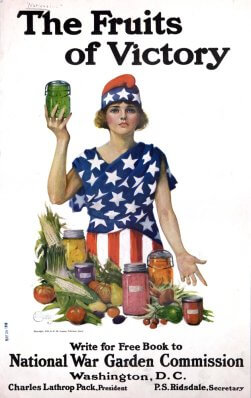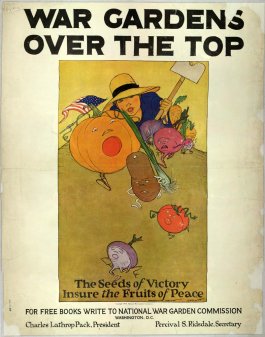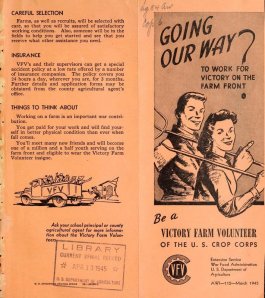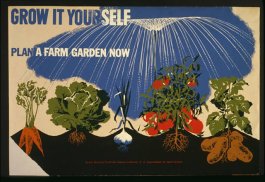There are a lot of points in history to begin talking about freedom gardens. The first thing that may come to mind for many people are the victory gardens (also known as war gardens or even food gardens for defense) grown as a response to shifting food production and distribution in World War I, then again in World War II.
In the U.S. during World War I, the Department of Agriculture and the National War Garden Commission produced posters and instructional pamphlets encouraging people to contribute to the war effort by planting gardens anywhere they could, from front lawns to window boxes to school grounds. The idea was that with so much food going to soldiers fighting abroad, we, the people, needed to supplement our own food supplies.

National War Garden Commission. 1918. “The Fruits of Victory.” Special Collections, USDA National Agricultural Library.

National War Garden Commission. 1919. “War Gardens Over the Top. The Seeds of Victory Insure the Fruits of Peace..” Special Collections, USDA National Agricultural Library.
Under the banner of freedom, victory, and patriotism, you could (and should!) learn to grow and preserve vegetables, and share them with your friends, family, and neighbors. During World War II, the U.S. Department of Agriculture produced numerous pamphlets and publications addressing topics from starting your own victory garden to insects and diseases to drying and canning.

U.S. Department of Agriculture. War Food Administration. Extension Service. 1945

1941 Poster for the U.S. Department of Agriculture promoting victory gardens, showing carrots, lettuce, onion, tomatoes, and potatoes growing.
Today’s freedom garden movement has some similarities. The basis of the idea is that growing your own food is economical, healthy, and can be a community resource. It’s a response to the uncertainty of our world with supply chain issues, climate change, and financial stress. It’s also a source of empowerment, care, and self-sufficiency. Growing a freedom garden is a revolutionary act that combats issues like food deserts and the high cost of organic, healthy fruits and vegetables.
But to link the freedom garden movement strictly to victory gardens is to miss a large part of the story. If freedom gardens are a response to the high cost of food, food insecurity, or even improving your diet, then you have to, at a minimum, look to the small personal gardens tended by enslaved people going back to the founding days of the U.S. These gardens supplemented the meager rations they had to survive on.
Add to that the many laws, policies, and social environments since then that have deprived Black people, immigrants, and indigenous people of viable farmland, and it’s easy to see the thread of personal gardening as a source of both necessity and community care that goes well beyond the victory garden movements of World War I and II. Of course, this merely skims the surface. Writers, historians, and gardeners like Michael W. Twitty, Ron Finley, Kathe Hambrick-Jackson, and Gail V. Wells have vast wells of knowledge and experience in these areas. And they’ve done a lot for their respective communities to impart that knowledge and encourage people to grow their own food.
Today, you may find a freedom garden on someone’s front porch, on a rooftop, in a formerly vacant lot, and at community centers. How is it different than any ordinary backyard garden? In some ways, it’s not much different at all. But the idea behind it, that we can support ourselves and our community by working together and sharing, is a more open and inclusive attitude. A freedom garden isn’t just about you or me. It’s about us.
Which brings me to this special issue from Food Gardening Network: Starting a Freedom Garden. Here’s a sneak peek at this issue:
- How to Start a Freedom Garden: Freedom Gardens are places where people can come together to share ideas, build community, make change happen, and create lasting solutions to complex problems. They provide an opportunity for people with diverse backgrounds and perspectives to connect and collaborate on meaningful projects.
- Creating an In-Ground or Raised Bed Garden: Cost-wise, planting directly in the ground is the cheapest and fastest way to get started. You can even use weed covers to protect your plants. What you don’t get is control over your soil. That’s not to say that one is better than the other. They’re just different. Here are some factors to consider.
- Creating a Front Porch or Patio Freedom Garden: If all you have for your garden is a front porch, the good news is that you still have a very wide selection of vegetables and herbs to choose from, many of which can thrive in containers. There’s even a hybrid variety of corn (Burpee’s On Deck Hybrid) that’s bred specifically for container gardens.
- Creating a Greenhouse Freedom Garden: Greenhouses don’t have to be enormous. They can actually be pretty tiny. We’ve seen people turn their porches into greenhouses. You can buy greenhouse kits and build your own. But what should you grow in a greenhouse?
- Planning Out Your Freedom Garden: Are you a digital native or do you prefer to go analog with pen and paper? Either way, there are numerous tools out there to help you plan your garden.
Once you have the basics down, it’s time to take the next steps. A little extra effort will offer big returns in keeping your plants protected from pests and disease, keeping your soil healthy, and giving you a bigger harvest.
- Companion Planting Basics for a Freedom Garden: If you want healthy, thriving plants, fewer pests, and more pollinators in your garden, companion planting is an easy, organic way to accomplish your goals. Companion plants have mutually beneficial relationships, and there are any number of ways these plants might help each other.
- Crop Rotation Basics for a Freedom Garden: If you have a small backyard plot for your Freedom Garden, or a porch garden, or a space where you grow herbs beside your kitchen window, you might wonder what kind of crop rotation advantages really exist—or are possible—when your garden is a 10′ x 10′ square… Or smaller… Or bigger… But as tempting as it might be, it’s best not to grow the same crops in the same soil for more than one growing season.
- Storing Food from Your Freedom Garden: There are several methods for storing food without refrigeration and each method comes with its own set of instructions and best practices. Here are some food preservation tips for each kind of method.
There’s a lot more in this special edition of Food Gardening Magazine. You’ll find a printable Companion Planting Chart showing dozens of herb and vegetable combinations that work well together in the garden. You’ll get tips for canning, drying, and fermenting and you can read reviews of several low-cost garden planning apps. Explore topics such as soil quality, what to grow in a container garden, and some crop rotation ideas for small spaces.
We’re excited to share this issue with you and hope that you enjoy reading it.
Happy gardening—and happy eating!

Kim Mateus
Editor & Publisher
P.S. Please enjoy this issue of Food Gardening Magazine, and let me know what you think about it by commenting below with your feedback! Your input is valuable to us and can help us make improvements.




